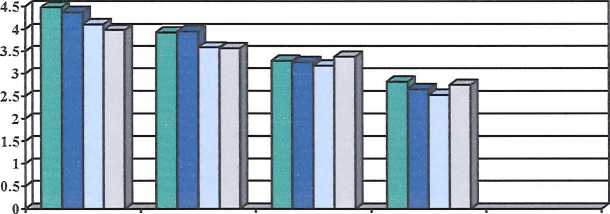123
Figure 4.2.1: Perceptions of pupils’ affective attitudes towards mathematics learning as
promoted by Practical work

□ enjoyment
□ motivation
□ sense of security
□ sense of progerss
I 5lh grade teachers ∣ 8th grade teachers ∣ 5lh graders ∣ 8th graders
Table 4.2.1: Perceptions of pupils’ affective attitudes towards mathematics learning as
promoted by Practical work
|
5lh grade teachers_______ |
8th grade teachers_______ |
5lr graders________________ |
8ltl graders_________________ | |||||||||
|
N |
Mean |
SD |
N |
Mean |
SD |
N_____ |
Mean |
SD |
N |
Mean |
SD | |
|
Enjoyment________ |
48 |
4.48 |
.58 |
42 |
3.93 |
1.05 |
1479 |
3.29 |
1.33 |
2156 |
2.82 |
1.36 |
|
Motivation__________ |
48 |
4.38 |
.79 |
42 |
3.95 |
.76 |
1479 |
3.26 |
1.34 |
2149 |
2.66 |
1.29 |
|
Sense of security |
47 |
4.11 |
.67 |
39 |
3.59 |
.82 |
1473 |
3.18 |
1.30 |
2141 |
2.53 |
1.20 |
|
Sense of progress |
48 |
3.98 |
.73 |
42____ |
3.57 |
.83 |
1474 _ |
3.38 |
1.31 |
2143 |
2.75 |
1.26 |
|
Repeated |
F(2.401,110.455)=8.037, |
F(2.340, 88.934)=4.145 |
F(2.819,4135.601)=13.379, |
F(2.750, 5861.134)=51.600 | ||||||||
|
Deployment_______ |
48____ |
2.96 |
•77 |
42 |
2.12 |
.86 |
1476 |
1241 |
I -92 |
2142 |
1.42 |
ππ |
Using a computer
Figure 4.2.2 and Table 4.2.2 below indicate that both teachers and pupils perceived that
Using a computer promoted pupils’ enjoyment and motivation more than their sense of
security and sense of progress. Teachers and pupils of both age groups reported that on
average computers were never used in mathematics classes so their assessment of the
effect on attitudes to learning mathematics were not likely to be based on their
experiences in school.
Figure 4.2.2: Perceptions of pupils’ affective attitudes towards mathematics learning as
promoted by Using a computer

I 5tl grade teachers ∣ 8th grade teachers ∣ 5th graders ∣ 8lh graders
More intriguing information
1. National curriculum assessment: how to make it better2. The Values and Character Dispositions of 14-16 Year Olds in the Hodge Hill Constituency
3. Higher education funding reforms in England: the distributional effects and the shifting balance of costs
4. Testing the Information Matrix Equality with Robust Estimators
5. Empirically Analyzing the Impacts of U.S. Export Credit Programs on U.S. Agricultural Export Competitiveness
6. Developments and Development Directions of Electronic Trade Platforms in US and European Agri-Food Markets: Impact on Sector Organization
7. Secondary school teachers’ attitudes towards and beliefs about ability grouping
8. The name is absent
9. CONSIDERATIONS CONCERNING THE ROLE OF ACCOUNTING AS INFORMATIONAL SYSTEM AND ASSISTANCE OF DECISION
10. The name is absent